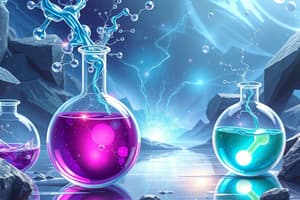Podcast
Questions and Answers
A patient presents with muscle weakness, fatigue, and confusion. A BMP reveals a sodium level of 120 mEq/L. Which of the following conditions is most likely?
A patient presents with muscle weakness, fatigue, and confusion. A BMP reveals a sodium level of 120 mEq/L. Which of the following conditions is most likely?
- Hyponatremia (correct)
- Hyperkalemia
- Hypokalemia
- Hypernatremia
Which of the following medications is most likely to cause hyperkalemia?
Which of the following medications is most likely to cause hyperkalemia?
- Losartan, an ARB
- Lisinopril, an ACE inhibitor (correct)
- Hydrochlorothiazide, a thiazide diuretic
- Furosemide, a loop diuretic
In what way are calcium and phosphate related in the body?
In what way are calcium and phosphate related in the body?
- They have an inverse relationship, where an increase in calcium often leads to a decrease in phosphate, and vice versa. (correct)
- Calcium directly stimulates the renal excretion of phosphate.
- They have a direct relationship, where changes in calcium levels directly correlate with changes in phosphate levels.
- They are unrelated and do not affect each other's levels.
Which of the following is NOT typically included in a Basic Metabolic Panel (BMP)?
Which of the following is NOT typically included in a Basic Metabolic Panel (BMP)?
A patient's BMP results show a potassium level of 6.8 mEq/L. Which of the following EKG changes would you most likely observe?
A patient's BMP results show a potassium level of 6.8 mEq/L. Which of the following EKG changes would you most likely observe?
A patient's serum creatinine level doubles within a short period. What percentage decrease in Glomerular Filtration Rate (GFR) does this suggest?
A patient's serum creatinine level doubles within a short period. What percentage decrease in Glomerular Filtration Rate (GFR) does this suggest?
Which of the following conditions would NOT typically cause an increased glucose level as measured in a Basic Metabolic Panel (BMP)?
Which of the following conditions would NOT typically cause an increased glucose level as measured in a Basic Metabolic Panel (BMP)?
A physician orders a Comprehensive Metabolic Panel (CMP) instead of a Basic Metabolic Panel (BMP). What additional information will the CMP provide?
A physician orders a Comprehensive Metabolic Panel (CMP) instead of a Basic Metabolic Panel (BMP). What additional information will the CMP provide?
Blood Urea Nitrogen (BUN) levels reflect the health of which two organs?
Blood Urea Nitrogen (BUN) levels reflect the health of which two organs?
A patient's Basic Metabolic Panel (BMP) reveals an elevated creatinine level. This result is directly proportional to what?
A patient's Basic Metabolic Panel (BMP) reveals an elevated creatinine level. This result is directly proportional to what?
Why is creatinine considered a useful filtration marker for estimating Glomerular Filtration Rate (GFR)?
Why is creatinine considered a useful filtration marker for estimating Glomerular Filtration Rate (GFR)?
Which of the following is NOT a component of the Basic Metabolic Panel (BMP)?
Which of the following is NOT a component of the Basic Metabolic Panel (BMP)?
Urea formation in the liver is a process that involves the breakdown of ingested proteins into amino acids, followed by catabolism to form ammonia. What is ammonia then converted into?
Urea formation in the liver is a process that involves the breakdown of ingested proteins into amino acids, followed by catabolism to form ammonia. What is ammonia then converted into?
Flashcards
Basic Metabolic Panel (BMP)
Basic Metabolic Panel (BMP)
A set of blood tests that give an overview of your body's metabolism and electrolyte balance.
Hypernatremia
Hypernatremia
Too much sodium in the blood; causes thirst, confusion.
Hyponatremia
Hyponatremia
Too little sodium in the blood; causes nausea, headache, confusion.
Medication causes of Hyperkalemia
Medication causes of Hyperkalemia
Signup and view all the flashcards
Calcium and Phosphate Relationship
Calcium and Phosphate Relationship
Signup and view all the flashcards
Bicarbonate (HCO3-)
Bicarbonate (HCO3-)
Signup and view all the flashcards
Creatinine
Creatinine
Signup and view all the flashcards
Creatinine Reference Range
Creatinine Reference Range
Signup and view all the flashcards
Blood Urea Nitrogen (BUN)
Blood Urea Nitrogen (BUN)
Signup and view all the flashcards
Normal BUN Range
Normal BUN Range
Signup and view all the flashcards
Glucose
Glucose
Signup and view all the flashcards
Glycosylated Hemoglobin (HbA1c)
Glycosylated Hemoglobin (HbA1c)
Signup and view all the flashcards




